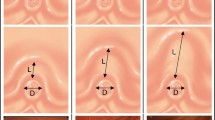Abstract
Background: Problems with intubation of the ampulla Vateri during diagnostic and therapeutic endoscopic maneuvers are a well-known feature. The ampulla Vateri was analyzed three-dimensionally to determine whether these difficulties have a structural background. Methods: Thirty-five human greater duodenal papillae were examined by light and scanning electron microscopy as well as immunohistochemically. Results: Histologically, highly vascularized finger-like mucosal folds project far into the lumen of the ampulla Vateri. The excretory ducts of seromucous glands containing many lysozyme-secreting Paneth cells open close to the base of the mucosal folds. Scanning electron microscopy revealed large mucosal folds inside the ampulla that continued into the pancreatic and bile duct, comparable to valves arranged in a row. Conclusions: Mucosal folds form pocket-like valves in the lumen of the ampulla Vateri. They allow a unidirectional flow of secretions into the duodenum and prevent reflux from the duodenum into the ampulla Vateri. Subepithelial mucous gland secretions functionally clean the valvular crypts and protect the epithelium. The arrangement of pocket-like mucosal folds may explain endoscopic difficulties experienced when attempting to penetrate the papilla of Vater during endoscopic retrograde cholangiopancreaticographic procedures.
Similar content being viewed by others
Author information
Authors and Affiliations
Rights and permissions
About this article
Cite this article
Paulsen, F., Bobka, T., Tsokos, M. et al. Functional anatomy of the papilla Vateri. Surg Endosc 16, 296–301 (2002). https://doi.org/10.1007/s00464-001-9073-y
Received:
Accepted:
Published:
Issue Date:
DOI: https://doi.org/10.1007/s00464-001-9073-y




